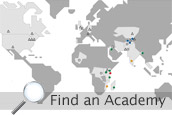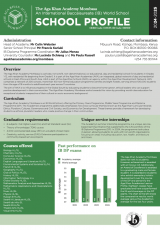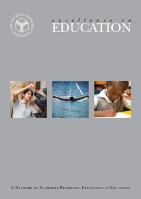Everyday Mombasa Project Launched at AKA, Mombasa
 A couple of weeks ago, our students began a social media project aimed at dispelling stereotypes about Africa as portrayed by the media. The project was led by two American journalists – Peter DiCampo and Austin Merrill. Peter is a freelance photographer who has worked for many different organizations, and Austin is currently an editor for Vanity Fair in New York. After collaborating on a project covering the conflict in the Ivory Coast a few years ago, both Austin and Peter realized the images of Africa portrayed in the media did not really capture the everyday essence of the place, and since then, they have been wielding their smartphones and uploading images on to various social media sites to counter some of the extreme stories with more ordinary, but just as compelling, narratives of Everyday Africa.
A couple of weeks ago, our students began a social media project aimed at dispelling stereotypes about Africa as portrayed by the media. The project was led by two American journalists – Peter DiCampo and Austin Merrill. Peter is a freelance photographer who has worked for many different organizations, and Austin is currently an editor for Vanity Fair in New York. After collaborating on a project covering the conflict in the Ivory Coast a few years ago, both Austin and Peter realized the images of Africa portrayed in the media did not really capture the everyday essence of the place, and since then, they have been wielding their smartphones and uploading images on to various social media sites to counter some of the extreme stories with more ordinary, but just as compelling, narratives of Everyday Africa.
 However, this is the first time the two journalists have taken the project outside the US and collaborated with an African school. They also brought in Kenyan journalists Boniface Mwangi and Muhammad Ali to lend a unique local perspective to the proceedings. Our students, together with a few students from other local schools, ran parallel workshops with pupils at Nicholas Senn High School in Chicago, and at the end of their workshop, shared their respective photo essays centered on a particular theme that captured everyday life in Mombasa. The week-long workshop started with a Skype session where students shared their preconceived notions about Kenya and the US respectively. Although some of the responses had been rather extreme, highlighting poverty, violence and tension, the students were not entirely surprised by the images portrayed about them to their peers on the other side of the world. “It was what I had been expecting, but at the back of my mind I had hoped for the list to surprise me,” said Yasmyn Ntege, a Year 10 student at AKA, Mombasa.
However, this is the first time the two journalists have taken the project outside the US and collaborated with an African school. They also brought in Kenyan journalists Boniface Mwangi and Muhammad Ali to lend a unique local perspective to the proceedings. Our students, together with a few students from other local schools, ran parallel workshops with pupils at Nicholas Senn High School in Chicago, and at the end of their workshop, shared their respective photo essays centered on a particular theme that captured everyday life in Mombasa. The week-long workshop started with a Skype session where students shared their preconceived notions about Kenya and the US respectively. Although some of the responses had been rather extreme, highlighting poverty, violence and tension, the students were not entirely surprised by the images portrayed about them to their peers on the other side of the world. “It was what I had been expecting, but at the back of my mind I had hoped for the list to surprise me,” said Yasmyn Ntege, a Year 10 student at AKA, Mombasa.
However, the students also recognized that the media plays an almost exclusive role in shaping the perceptions others have of Africa. “I think that they should not be blamed for the perceptions that they have because they have got these ideas from the media, books, movies, documentaries and many other sources that normally show the poverty and the bad living conditions in Africa,” observes Azaan Sachineda, one of the visiting students from Shree Swaminarayan Academy.
 The students then began lessons that took them through the technical aspects of photography, as well as developing a skill in recognizing good photos from bad ones. They also went out on shoots that allowed them to photograph various subjects depending on an overarching theme they had decided upon. Apart from trying to get the photography right, they also faced various challenges in the field when attempting to persuade people to be the subject of their portraits. “I definitely will change the way I approach people, as your manner matters a lot. It is also very important to be conversant with people, as it leaves them more comfortable for you to take a photo of them,” reflects Genesis Mungufeni, an AKA, Mombasa student in DP1. Soon enough, however, the shoots became equally about taking interesting pictures as about capturing the stories behind them. The students were trained to strike a rapport with their potential subjects beforehand, and this resulted in some remarkable tales, regardless of whether or not these encounters yielded a picture to go with them. “I think my most significant interaction was with a young lady named Wangari who was selling hot dogs at the end of Msharia Street. She had been working there for only three weeks and was trying to obtain extra money to pay for her nursing degree in Mombasa… I didn’t get many pictures because of the light, but talking to her and understanding her background even though I knew I wasn't going to use her pictures was refreshing and I feel more dedicated to this project,” Yasmyn related.
The students then began lessons that took them through the technical aspects of photography, as well as developing a skill in recognizing good photos from bad ones. They also went out on shoots that allowed them to photograph various subjects depending on an overarching theme they had decided upon. Apart from trying to get the photography right, they also faced various challenges in the field when attempting to persuade people to be the subject of their portraits. “I definitely will change the way I approach people, as your manner matters a lot. It is also very important to be conversant with people, as it leaves them more comfortable for you to take a photo of them,” reflects Genesis Mungufeni, an AKA, Mombasa student in DP1. Soon enough, however, the shoots became equally about taking interesting pictures as about capturing the stories behind them. The students were trained to strike a rapport with their potential subjects beforehand, and this resulted in some remarkable tales, regardless of whether or not these encounters yielded a picture to go with them. “I think my most significant interaction was with a young lady named Wangari who was selling hot dogs at the end of Msharia Street. She had been working there for only three weeks and was trying to obtain extra money to pay for her nursing degree in Mombasa… I didn’t get many pictures because of the light, but talking to her and understanding her background even though I knew I wasn't going to use her pictures was refreshing and I feel more dedicated to this project,” Yasmyn related.
 The students also spent some time thinking about the objectivity of the media, and how certain factors can influence the perspective from which a story is told by a particular source. When analyzing prominent stories about local violence, Ferdous Nadim, a Form 3 (Grade 9) student from Makande Girls Secondary School said “It feels bad because the people being talked about and harassed are some of the people from my community and religion.” However, they examined some of the reasons that would push media outlets to portray stories in this way. Political influences, as well as an idea of what is commercially viable are some of the common factors identified by the students that could warp the perspective a story is told from. “…There is no such thing as media objectivity… since objective doesn’t sell, depending on the location of the media house, as the government and the ideals of the target audience are constantly influencing what the media house says,” reflects Yohan Mutta, a Year 9 AKA, Mombasa student. They also recognized that the interpretation of a story is as significant as the perspective from which it is told. “In my opinion absolute media objectivity is hard to achieve because views are always in some way filtered by the receiver and giver of the news,” says Paul Kiage, an AKA, Mombasa DP1 student.
The students also spent some time thinking about the objectivity of the media, and how certain factors can influence the perspective from which a story is told by a particular source. When analyzing prominent stories about local violence, Ferdous Nadim, a Form 3 (Grade 9) student from Makande Girls Secondary School said “It feels bad because the people being talked about and harassed are some of the people from my community and religion.” However, they examined some of the reasons that would push media outlets to portray stories in this way. Political influences, as well as an idea of what is commercially viable are some of the common factors identified by the students that could warp the perspective a story is told from. “…There is no such thing as media objectivity… since objective doesn’t sell, depending on the location of the media house, as the government and the ideals of the target audience are constantly influencing what the media house says,” reflects Yohan Mutta, a Year 9 AKA, Mombasa student. They also recognized that the interpretation of a story is as significant as the perspective from which it is told. “In my opinion absolute media objectivity is hard to achieve because views are always in some way filtered by the receiver and giver of the news,” says Paul Kiage, an AKA, Mombasa DP1 student.
 Nevertheless, the students acknowledged that telling stories with facts alone would not get the message across, and brainstormed ideas about how the media could work on delivering stories from a more objective standpoint. Rithwik Gokhale, an AKA, Mombasa Year 10 student, suggested that articles should “…have more facts …and less personal opinions, separate articles and sections can be made for the opinions of the author. But at the same time if an article only has facts, it becomes boring. The solution to that could be to state a fact and then explain the fact in more detail. I think that this would be the best way to improve media objectivity.” Ashley Ndaise, a Year 9 student at AKA, Mombasa, speculated on the growing role played by social media in delivering news from different perspectives. “…on Instagram [for example], there are many different people that post and therefore even if there are some other biased posts, I am still able to view and review different ones in order to come up with a fair judgment on whatever the situation is.”
Nevertheless, the students acknowledged that telling stories with facts alone would not get the message across, and brainstormed ideas about how the media could work on delivering stories from a more objective standpoint. Rithwik Gokhale, an AKA, Mombasa Year 10 student, suggested that articles should “…have more facts …and less personal opinions, separate articles and sections can be made for the opinions of the author. But at the same time if an article only has facts, it becomes boring. The solution to that could be to state a fact and then explain the fact in more detail. I think that this would be the best way to improve media objectivity.” Ashley Ndaise, a Year 9 student at AKA, Mombasa, speculated on the growing role played by social media in delivering news from different perspectives. “…on Instagram [for example], there are many different people that post and therefore even if there are some other biased posts, I am still able to view and review different ones in order to come up with a fair judgment on whatever the situation is.”
Everyday Mombasa was launched on Wednesday, 4 March 2015, after the students had displayed their photo essays to their peers and teachers. These essays will also be shared with their counterparts in Chicago, and the Instagram feed, which you can explore here, will be constantly updated with images and stories depicting the special but overlooked stories about daily life in this city.
You can also follow Everyday Africa’s work on Instagram, Tumblr, Facebook, and Twitter.
In the spirit of Everyday Africa and Everyday Mombasa, all photos appearing in this article have been taken with a smartphone instead of a conventional camera.
For Newsletter readers, return to latest newsletter here





